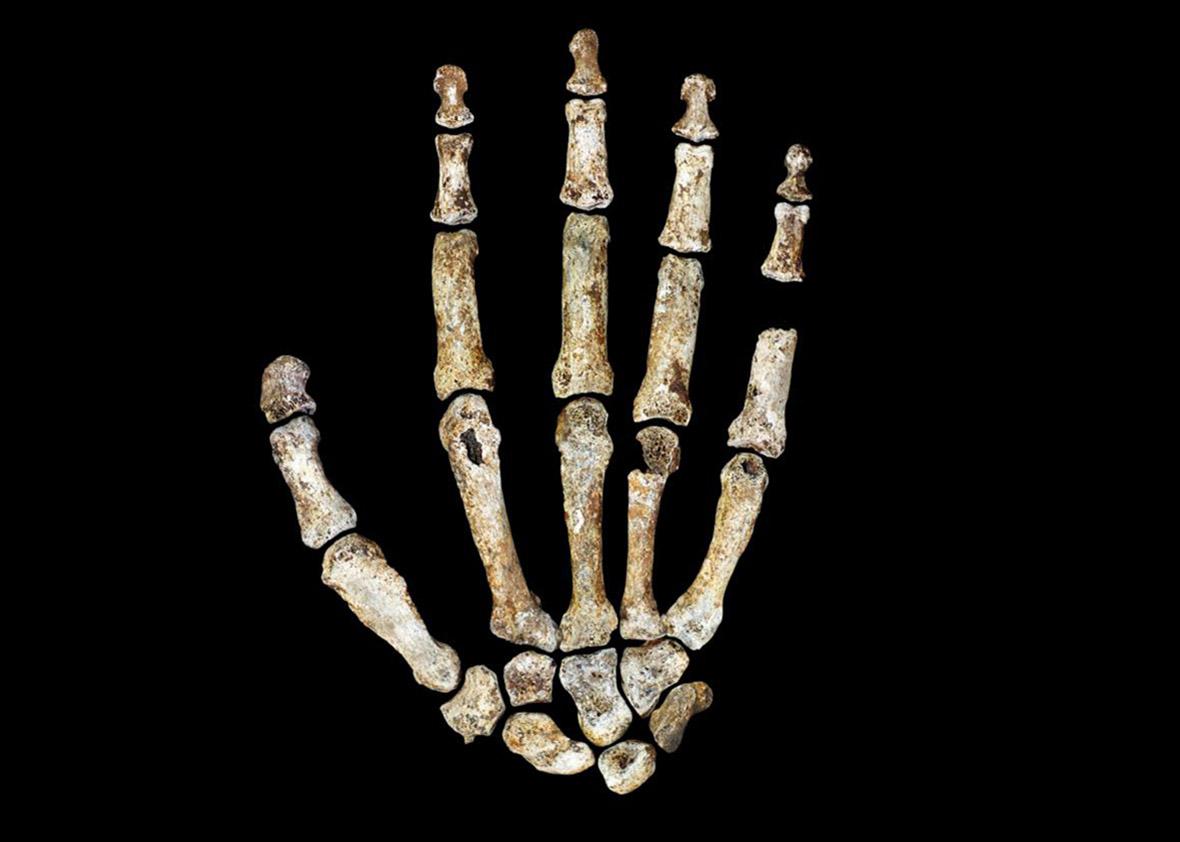It’s easy to forget the marvel of human hands. Musicians’ hands play masterful compositions on the piano; artists’ hands paint timeless works; surgeons’ hands save lives. The rest of us use our miraculous hands to get dressed, pour coffee, and type messages—sometimes entirely with our opposable thumbs.
Like our big brains, our agile hands are part of what makes us human. The construction of nerves, tendons, and bones is a result of millions of years of evolution. But how exactly did they get that way? And when did they emerge on our evolutionary timeline?
The fossilized hand bones of our human ancestors, including those of the recently discovered species Homo naledi, give us some clues. Homo naledi has a strange mix of modern human and not-so-modern features. Among them is a puzzling pair of hands: The wrist, palm, and thumb look like ours, but the long, curved fingers are more apelike. We’ve never seen anything like it.
This mix of features “gives us that smoking gun for how the hand was being used,” Matt Tocheri, a hand expert and paleoanthropologist with the Smithsonian’s Human Origins Program, told me. Tocheri co-authored a study published in Nature that analyzed a nearly complete right hand of an adult Homo naledi specimen. Its curved fingers mean it was regularly climbing trees, but its wrist, thumb, and palm suggest it was using tools.
Once our hands and wrists adapted for manipulating tools, it was thought that we would have to give up daily tree climbing. “We didn’t expect to see a hominin revert back to what we would consider ancestral-like behaviors—a more arboreal lifestyle,” Tocheri says. As Tocheri puts it, this unexpected behavioral combination is “pushing the envelope of human diversity.”
The remains of Homo naledi, which a paleoanthropologist recently suggested are about 2 million years old, have the potential to shift the arrangement of our family tree. Whatever we learn about this odd species, our understanding of human evolution will always involve a careful study of our hands.
Charles Darwin wrote in his 1871 The Descent of Man: “Man could not have attained his present dominant position in the world without the use of his hands which are so admirably adapted to act in obedience to his will.” In other words, we owe our hands a lot.
Since the late 19th century, Darwin’s observation has been grounded in paleoanthropology. In the 1960s, two of the field’s pioneers, Louis and Mary Leakey, found a relatively large-brained hominid in Tanzania. They called it Homo habilis or “handy man,” because its remains were found in the same area as thousands of primitive stone tools. The 1.4-million-to-2.4-million-year-old species was thought to be the first stone toolmaker. That title has since been rescinded—we’ve now dated the first stone tools to about 3.3 million years ago, which were possibly made by the species Australopithecus afarensis.
John Napier, a surgeon and primatologist who helped study Homo habilis, deemed the hand “the single most crucial adaptation in our evolutionary history.” Our hands helped make possible tool use, language development, the enlargement of our brain, and even human culture.
The paw-to-hand shift most likely started when early hominids started to walk upright. When we became bipedal, says Mary Marzke, a physical anthropologist at Arizona State University, the hand was used more for manipulating things and less for climbing, hanging, or bearing weight. As the theory goes, our hands were freed up for things like tool-making and gesturing to one another.
But as Homo naledi’s hands show us, the relationship between tool use and hand development was not fixed. Marzke says the two probably developed in tandem. Our tools progressed from simple stone axes to carefully crafted harpoons as our hands became more humanlike: a flexible palm, an opposable thumb, and shorter, straighter fingers. We adopted a precision grip, which allowed us to pinch objects between our thumb and fingers. Our tool manipulation became much more sophisticated.
As British philosopher Colin McGinn points out in his book Prehension, new tools led to new grips, and new grips led to new tools. And as our tool use grew, so did the size of our brains. From Homo habilis to Homo sapiens, our brain capacity nearly doubled, and we started to experiment with innovative and creative methods.
Neurologist Frank Wilson argues in his book The Hand: How Its Use Shapes the Brain, Language, and Human Culture that using our hands to make things was “an impetus to the redesign of the brain’s circuitry.” As Wilson told me, “What the hand and the brain as a system accomplished is the capacity to adapt to what was unexpected.”
Beyond learning how to make things like harpoons, we also used our hands to learn how to communicate with each other. What started as gestures evolved into simple vocalizations and eventually complex patterns of speech. When you combine language with invention, you get a foundation for culture, which is fortified through the trust-building power of touch.
Using our human brainpower, we can teach our hands to do almost anything. And yet, it seems as if our propensity for “hands-on learning” is waning as we continue to make technological advances. Our flexible opposable thumb is used more and more for texting on our smartphones, and our straight fingers are spending hours typing while we stare at screens. Are we wasting our hands’ unique capabilities? It might take another million years of evolution to find that out.
